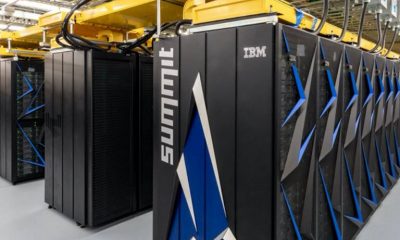Emerging Tech
What are supercomputers and why are they important? An expert explains

Supercomputers will play a major role in shaping humanity’s future. Here’s how.
-
Supercomputing systems have already helped scientists overcome tough challenges, like isolating and identifying the spike protein in the COVID-19 virus.
-
Supercomputers will play a major role in shaping humanity’s future.
-
HPE’s Justin Hotard, a high-performance computing expert, explains how supercomputers are enabling breakthrough technologies that will change the world.
In a complex, ever-changing world, processing data to get actionable results quickly is more important than ever. Supercomputers will play an important role in this – something Justin Hotard knows well.
He’s the executive vice president and general manager overseeing the high-performance computing and artificial intelligence business group and labs at Hewlett Packard Enterprise. His role helps deliver bleeding-edge technologies that enable scientists, technologists, and researchers to make the world a better place. The company recently invested more than $22 million in a special Global Center of Excellence for High-Performance Computer Manufacturing Center in the US, and Hotard spoke with Agenda about what we need to understand about this technology and its potential for solving some of the world’s most complex problems.
This interview has been edited for clarity and condensed.
Agenda: What is a supercomputer?
Justin Hotard: Supercomputers are the largest and most powerful computers in the world. These computers leverage a memory block along with multiple central processing units grouped into ‘compute nodes’ – sometimes tens of thousands of nodes. Imagine if you had not one laptop, but 50,000 laptops all connected together, running one piece of software that needed all of those 50,000 laptops to run together at the same time.
Agenda: Why are supercomputers important?
Justin Hotard: Supercomputing enables problem-solving and data analysis that simply would be too time-consuming or costly with standard computers.
Agenda: How are supercomputers different from quantum computers?
Justin Hotard: Supercomputing uses the same core technology that we use today in laptops or graphics accelerators from companies like Invidia and AMD, but with the most advanced techniques possible, whereas quantum computing fundamentally is a different way of computing.
Agenda: How are supercomputers unique?
Justin Hotard: What’s unique about a supercomputer is that we can’t use traditional methods to cool and power them, so we tend to use very specialized systems that can take a lot of power and actually use water to cool them, which is much more thermally and energy-efficient That’s what allows us to deliver incredible breakthroughs, such as finding cures for diseases, solving questions around complex energy problems, and progressing material science.
Agenda: How has supercomputing made a key difference in the world?
Justin Hotard: During the pandemic, an HPE supercomputer helped scientists isolate and identify the spike protein in COVID-19. Before the supercomputer was employed, researchers didn’t have a way of characterizing the protein. After that, companies and countries could design, develop, and ultimately lead them to be able to test and implement vaccines. The computer was able to take millions of different data sets leveraging proteins from all over the world and study that against the COVID-19 protein and understand the spike proteins attributes.
Agenda: How is supercomputing helping the climate?
Justin Hotard: A great example is what we’re doing with wind farms. Our newest supercomputers are going help us optimize and more accurately predict wind farm behavior, integrating climate trends, the local turbulence from the wind turbines themselves, and other factors so that we can maximize the efficiency of those wind turbines.
Agenda: What impact will supercomputing have on the world in 20 years?
Justin Hotard: These powerful supercomputers will enable greater scientific research and new opportunities to learn. Hopefully, we’ll see a cure for some cancers that we have battled for years. I think we’ll also see greater energy efficiency and new breakthroughs in material technologies.
And it will also enable the Metaverse and the future of space. These large computers allow you to simulate very complex environments. And if you think about the metaverse, and you really imagine the future of immersive reality, there are so many dimensions that we take for granted. There’s the physical movement, there’s touch, there’s pressure, there’s temperature, there’s smell, let alone sound and audio and visual. All of those are very complex to simulate.
These computers will allow us to simulate in ways that we can build software around them. So when someone is in an immersive experience, they can feel the different sense of walking on a carpet versus a wood floor. They can sense the difference in temperature between having the air conditioning on or not. And that’s really critical when you think about creating a truly immersive experience versus augmented reality.
Agenda: If supercomputers didn’t exist, how would the metaverse develop differently?
Justin Hotard: It would develop much more slowly. It’d be much more of a linear progression in which you would solve one problem and then solve the next problem. You probably wouldn’t get that speed of integration, the speed of the experience to users. Supercomputing creates a lot more breadth and opportunity for use cases that we probably haven’t considered beyond just consumer entertainment use cases, such as defense or industry.
Supercomputers also could give people the experience of an immersive perspective of being in space. Or teleporting somewhere and potentially having a meeting such as the World Economic Forum with everyone actually virtually attending — getting the experience of sitting just across the room from someone while we’re all in different places. The experience is real.
You also could imagine any kind of physical training – for instance, a team practicing for its next match and seeing its competitor’s behavior be simulated and having to respond.
Agenda: What’s needed to scale this technology?
Justin Hotard: Public-private partnership has been critical in getting this industry as far as it has come. And it needs to expand because too much for one country, or a couple of large countries, to invest in alone. Everyone needs to invest and enable these partnerships and ultimately see the benefits to their interests — their scientific interests, their sovereignty interests, their economic interests, and beyond. We need to see collaboration.
We have a great customer in Finland – the LUMI (Large Unified Modern Infrastructure) consortium of states across Europe that have come together to build a supercomputer. And it’s a great example, because not only have these states come together to build something that none of them could have built independently, but now they’re enabling access to their scientists, to their companies, to their entire economies to take advantage of this capability. That’s one small example of the kind of benefit that a public-private partnership can bring.
”
— Justin Hotard, Hewlett Packard Enterprise
We also need continued community collaboration. We talk a lot about open-source development, and this is a community that does more than that, where members truly help each other. And I think we need to see that continue and broaden. This collaboration helps break through technological barriers. It helps push scientific boundaries and it gives the community ideas on how to ultimately build and deliver our systems. We’re very dependent on that community for success, and I think it’s very important.
The last thing I’ll say is we need scientists and engineers who understand this technology to cultivate the next generation. This is a space that has benefited from many visionaries over the last 30 to 40 years. Now we need to also cultivate that next generation to solve complex problems and make the world a better place. We’ve got to share that vision and share that future for the generation that’s going through school and ultimately coming into the workforce.



